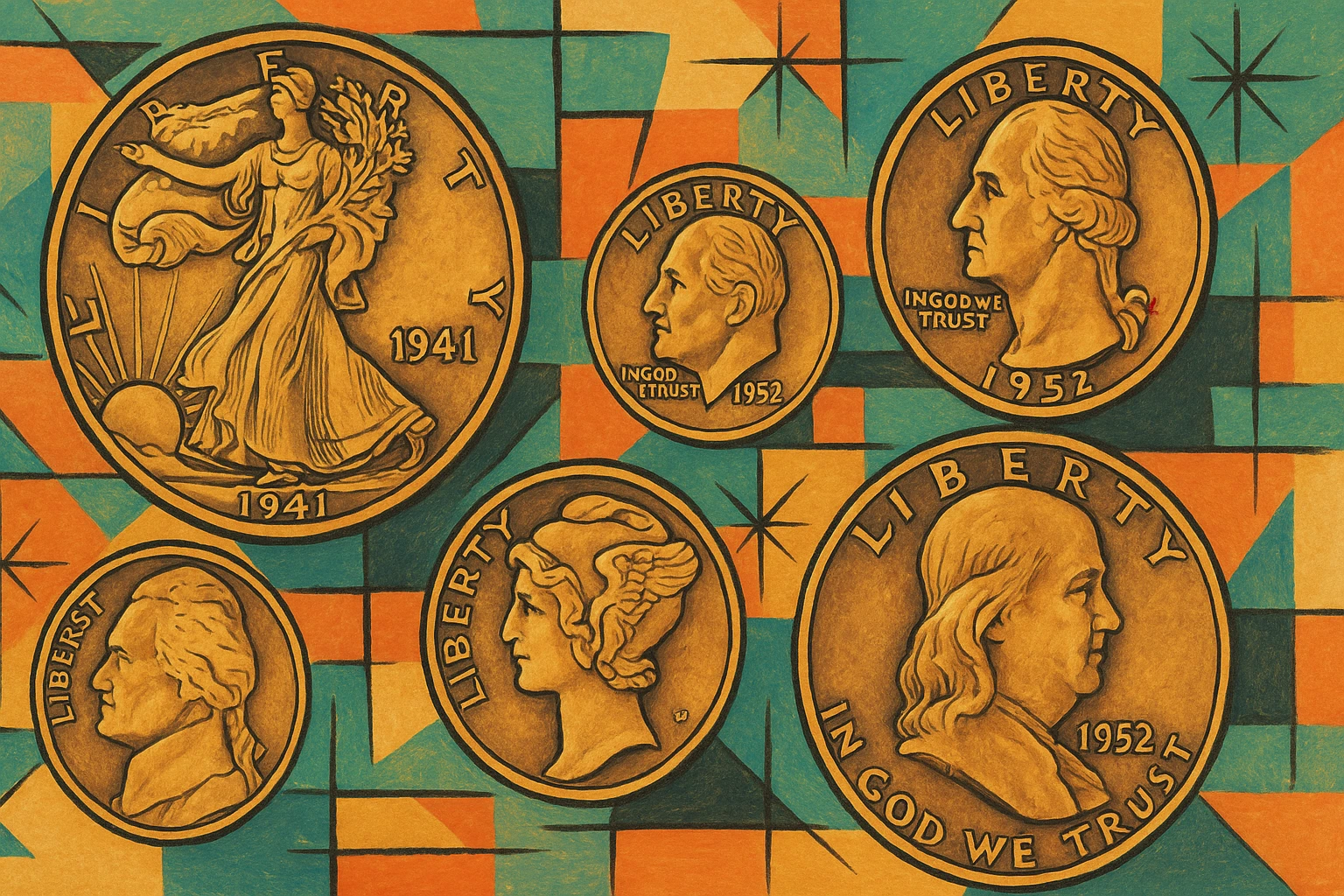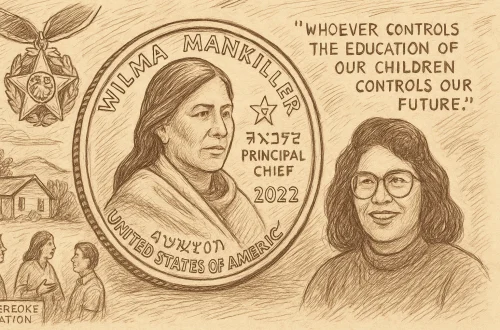Between the Great Depression and the postwar economic boom, the United States underwent immense transformation—economically, politically, and culturally. One unexpected lens through which we can observe this evolution is American coinage. The coins minted from the 1930s to the 1950s, just like the 1941 Walking Liberty half dollar, aren’t just forms of legal tender; they’re miniature historical documents, art pieces, and investment vehicles rolled into one.

The Golden Age of American Coin Design
The mid-20th century is considered by many numismatists to be a golden age in US coin production. Why? Because these decades brought together exceptional artistry, meaningful symbolism, and solid intrinsic value. These coins weren’t just designed for commerce—they were created with purpose, often reflecting the nation’s struggles, victories, and ideals.
Here are three key reasons these mid-century coins continue to attract attention:
- Historical Significance: Minted during major events like the Great Depression, World War II, and the early Cold War, many of these coins mirror pivotal national moments.
- Artistic Excellence: Designs from this era feature allegorical imagery, iconic American figures, and powerful symbolism.
- Precious Metal Content: Most coins from this time were made with high silver content—90% in many cases—making them valuable even as bullion.
Historical Themes That Defined the Era
These coins don’t just sit in folders—they tell stories. For instance, consider the early 1930s: a time of widespread unemployment and economic despair. As President Franklin D. Roosevelt initiated New Deal reforms, the US Mint released coins like the 1932 Washington Quarter, symbolizing national unity and resilience. Fast forward to the late 1940s, and we see coins like the Franklin Half Dollar, highlighting American innovation and intellectual heritage in the aftermath of WWII.
Each coin from this era subtly echoes what was happening in the country:
| Decade | Historical Context | Coin Highlights |
| 1930s | Great Depression, New Deal | Washington Quarter, Texas Centennial Half Dollar |
| 1940s | WWII, Postwar Recovery | 1941 Walking Liberty Half, Mercury Dime, Roosevelt Dime |
| 1950s | Cold War Tensions, Technological Advances | Franklin Half Dollar, Jefferson Nickel |
Spotlight: The 1941 Walking Liberty Half Dollar
Among all mid-century coins, the 1941 Walking Liberty Half Dollar stands out as a masterpiece—both in terms of beauty and historical weight. Designed by Adolph A. Weinman, this coin features Lady Liberty striding confidently toward the dawn of a new day, cloaked in the American flag and holding branches of oak and laurel, representing both peace and strength. On the reverse, a fierce bald eagle stands perched on a rock, wings slightly spread—a visual metaphor for a nation ready to rise and defend.
Why the 1941 version deserves particular attention:
- Context: Minted just as the United States was preparing for possible entry into WWII. Its imagery conveyed hope during a time of global uncertainty.
- Mintage: Over 43 million coins were produced across three mints—Philadelphia, Denver, and San Francisco. The Philadelphia Mint alone struck over 15,000 proof coins.
- Market Value: A circulated 1941 Walking Liberty Half Dollar generally fetches between $17 and $50, while uncirculated or proof versions can sell for hundreds or thousands at auction.
This coin’s enduring appeal led to its resurrection on the American Silver Eagle bullion coins, first issued in 1986—a testament to its timeless design.
A Collector’s Secret Weapon: Coin ID Scanner
In an era where technology meets tradition, collectors don’t have to rely solely on books or guesswork. The Coin ID Scanner app makes identifying, valuing, and learning about coins like the 1941 Walking Liberty Half Dollar effortless. By simply scanning a coin, users can get instant feedback on its condition, market value, and historical background. It’s a must-have for anyone diving into mid-century US coinage.
Beyond the Walking Liberty: Other Must-Have Mid-Century Coins
While the 1941 Walking Liberty Half Dollar might steal the spotlight, it’s far from the only gem minted during this rich era. The 1930s to 1950s gave rise to several iconic coins that continue to define American numismatics. These coins weren’t just beautiful—they marked milestones, honored presidents, and introduced innovative designs that left lasting impressions.
Let’s explore some of the standout coins from this transformative period and what makes each one a valuable collector’s item.
Washington Quarter (1932–present)
First issued in 1932 to celebrate the 200th anniversary of George Washington’s birth, the Washington Quarter was initially intended as a one-year commemorative coin. However, it quickly gained popularity and became the permanent replacement for the Standing Liberty Quarter.
- Design Details: Sculpted by John Flanagan, the obverse features a stately bust of Washington, while the reverse (until 1998) depicted an eagle with outstretched wings.
- Historical Significance: Arriving during the depths of the Great Depression, the coin symbolized stability and national pride.
- Collector Tip: Look for early dates like the 1932-D and 1932-S, which are considerably rare and can fetch hundreds or even thousands of dollars in high grade.
Jefferson Nickel (1938–present)
The Jefferson Nickel replaced the beloved Buffalo Nickel in 1938, ushering in a new era of coinage that aligned with modern sensibilities and honored the third US president.
- Design Highlights: Created by Felix Schlag, the obverse shows Jefferson in profile, while the reverse features his home, Monticello.
- Key Dates: Wartime nickels (1942–1945) are especially intriguing—they contain 35% silver due to wartime nickel shortages and have large mint marks above Monticello.
- Value Insight: Coins like the 1943-P “Full Steps” variety are highly desirable and can exceed $1,000 in pristine condition.
Mercury Dime (1916–1945)
Although the Mercury Dime predates the 1930s, many of its key issues continued into this period and are deeply tied to the era’s narrative.
- Design Excellence: Designed by Adolph Weinman, the obverse portrays Liberty wearing a winged cap—symbolizing freedom of thought. The reverse features a fasces and olive branch, denoting strength and peace.
- Popular Year: The 1942/1 overdate is one of the most famous and valuable varieties in the series.
- Why Collectors Love It: The combination of artistic flair and 90% silver content make it a must-have for any serious collection.
Roosevelt Dime (1946–present)
Following President Franklin D. Roosevelt’s death in 1945, the US Mint honored his legacy with the Roosevelt Dime, first struck in 1946.
- Why It Matters: Roosevelt was instrumental in founding the March of Dimes campaign to fight polio. The coin’s issuance became a symbolic gesture.
- Design Details: John Sinnock sculpted both sides—featuring Roosevelt on the obverse and a torch flanked by olive and oak branches on the reverse.
- Collector’s Note: Silver Roosevelt dimes minted from 1946 to 1964 are 90% silver and still widely found in collections or even coin rolls.
Franklin Half Dollar (1948–1963)
After the Walking Liberty design was retired, the Franklin Half Dollar entered circulation in 1948, celebrating Benjamin Franklin, a founding father known more for his intellect than military might.
- Design Innovation: Designed by John R. Sinnock, the obverse displays a profile of Franklin, while the reverse features the Liberty Bell—complete with its famed crack.
- Interesting Fact: It was one of the few US coins at the time to feature a non-president.
- High-Value Varieties: Look for “Full Bell Lines” (FBL) on the reverse—these clearly defined lines are rare in high-grade examples and command premium prices.
Commemorative Half Dollars of the 1930s
The 1930s also witnessed a flurry of commemorative half dollar releases. Although sometimes controversial due to perceived overproduction, these coins remain sought-after for their unique historical value and low mintages.
Notable Examples:
| Coin | Year(s) | Theme | Current Value (avg XF–MS) |
| Oregon Trail Memorial | 1926–1939 | Westward expansion and pioneer spirit | $90 – $500+ |
| Texas Centennial | 1934–1938 | 100 years of Texas independence | $80 – $450+ |
| Arkansas Centennial | 1935–1939 | Statehood and Southern heritage | $60 – $300+ |
Why They Matter: These coins offer a blend of state pride, American expansionism, and low production runs—ideal for collectors wanting historical flair.
How to Collect and Identify Coins from the 1930s–1950s
Venturing into the world of mid-century coin collecting is as rewarding as it is accessible. Whether you’ve inherited a family collection, picked up a few silver coins at a flea market, or discovered a stash in your drawer, these small artifacts can open a portal to American history. But collecting is more than just accumulating coins—it’s about knowing what to look for, how to care for them, and how to assess their true value.
Here’s a simple, actionable guide for getting started.

Step 1: Know the Key Dates and Mint Marks
The same coin design can vary greatly in value depending on the year and mint location. For example:
- 1941 Walking Liberty Half Dollar – common in general, but high-grade or proof versions command high prices.
- 1932-D and 1932-S Washington Quarters – extremely scarce and highly collectible.
- 1943-S Jefferson Nickel (silver wartime issue) – desirable in Full Steps condition.
- 1942/1 Mercury Dime – rare overdate error, worth hundreds or even thousands depending on grade.
Mint Marks Matter:
| Mint Mark | Mint Location | Where to Find It |
| No Mark | Philadelphia | Common default for older coins |
| D | Denver | Typically on the reverse (location varies) |
| S | San Francisco | Usually on the reverse as well |
Learning these small details can turn an average coin into a major discovery.
Step 2: Understand Coin Grading
The condition—or grade—of a coin dramatically affects its value. Coins are generally assessed using the Sheldon Scale, which runs from 1 (Poor) to 70 (Perfect Mint State). For instance:
- A 1948 Franklin Half Dollar in Fine (F12) condition might be worth $10, but the same coin in Mint State 65 (MS65) could fetch $300 or more.
- Proof coins or those with clear features like Full Bell Lines (FBL) or Full Steps (FS) on reverse imagery also command higher premiums.
If you’re unsure of your coin’s grade, don’t guess—use tools or consult professionals.
Step 3: Use Modern Tools Like Coin ID Scanner
Gone are the days of squinting at coin catalogs or relying on memory alone. The Coin ID Scanner app revolutionizes the hobby by allowing you to:
- Scan and Identify: Instantly recognize the coin and its mint year/mint mark.
- Check Real-Time Values: Get the latest market trends and auction data.
- Verify Authenticity: Detect counterfeits or cleaned coins that lower value.
- Organize Your Collection: Build a digital archive of your personal holdings.
This app is perfect for beginners and seasoned collectors alike—it turns your smartphone into a portable coin expert.
Step 4: Build Your Collection Strategically
Here are three popular collecting strategies for mid-century coins:
- Date Sets: Collect every year of a particular coin (e.g., every Mercury Dime from 1930–1945).
- Type Sets: One of each major design from the 1930s to 1950s (e.g., Walking Liberty Half, Franklin Half, Roosevelt Dime).
- Condition Sets: Focus on acquiring only coins in high grades, like MS65 or higher.
Each approach offers a different balance of historical insight, investment potential, and collecting challenge.
Step 5: Preserve and Store Properly
Once you begin building your collection, protecting it is crucial. Here’s how:
- Use Archival Holders: Avoid PVC flips that can damage coins over time.
- Store in a Cool, Dry Place: Humidity is a major threat to coin surfaces.
- Handle with Care: Hold coins by the edges and never clean them—this reduces their value dramatically.
Mid-century US coins are more than numismatic collectibles—they’re finely crafted symbols of an evolving nation. Each coin tells a story: of hardship during the Great Depression, resilience in World War II, innovation in the postwar boom, and shifting national identity. Whether you’re captivated by design, history, or the thrill of the hunt, these treasures from the 1930s to 1950s offer endless discovery.





